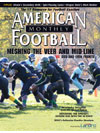AMERICAN FOOTBALL MONTHLY THE #1 RESOURCE FOR FOOTBALL COACHES
Article CategoriesAFM Magazine
|
The Five Keys to Drop Back Pass Protectionby: Ted NewsomeOffensive Line Coach, Portsmouth High School, OH © More from this issue Teaching fundamentals of drop back protection can be broken down into five phases. These five areas are the set, relative position, body position, lateral movement, and separation. In this article I will break down each of these phases in detail and provide a sound and proven fundamental approach to each. Before I go on I would like to say that this information has been gathered over several years of listening to and visiting with some of the top offensive line coaches in high school, college and at the professional level. I. Win The Set Everything in football begins with the stance. Pass protection is no different. A great stance should be one that allows you to easily move forward, backward, right or left. The stance must allow an offensive lineman to get set with the least amount of wasted motion. A st....The full article can only be seen by subscribers. Subscribe today!
|
|
|||||||
| HOME |
MAGAZINE |
SUBSCRIBE | ONLINE COLUMNISTS | COACHING VIDEOS |
Copyright 2025, AmericanFootballMonthly.com
All Rights Reserved





